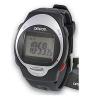

Home > HRM Overview > HRM Training
Heart Rate Monitor TrainingThe basic principles of heart rate monitor training are actually quite simple.
What is written above is actually an over-simplification. However, the general gist is there. An actual real heart rate training plan often will not merely consist of a single monotonous heart rate training zone which you do every single session. Not at all. An actual weekly training plan is likely to consist of higher intensity sessions alternating with lower intensity sessions (or complete rest). How it is actually structured depends on the goals and fitness of the individual. It is very important to note that the body does its adaptations during periods of rest. If the body is never given a chance to rest properly, fitness will instead decrease.
Not sure which heart rate monitor is right for you? Take a look at the Which Heart Rate Monitor page.
|

Polar FT4

Polar FT4 For Women

Timex T5G971 Personal Trainer

Polar FT2

Timex T5G941 Easy Trainer

Omron HR-100C